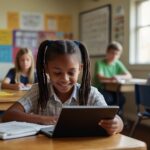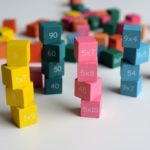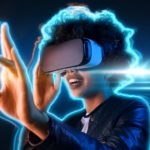As a classroom teacher, I’ve noticed a recurring theme in education: the disconnect between those who develop educational strategies and those who implement them. Nowhere is this gap more evident than in the current push for personalized learning technology, particularly in mathematics.
 The Promise vs. The Reality
The Promise vs. The Reality
The sales pitch is compelling: adaptive learning programs that adjust to each student’s level, providing personalized instruction and practice problems tailored to their exact needs. In theory, it’s the holy grail of differentiated instruction – every student working at their optimal level, receiving instant feedback, and progressing at their own pace.
But the reality in my classroom tells a different story.
Even with sophisticated algorithms and carefully designed “explanation buttons,” students consistently seek human interaction and guidance. And it’s not just struggling students – even our most advanced learners regularly need teacher support. Why? Because when they excel, the program gives them more challenging problems, which in turn requires more sophisticated explanation and guidance.
The Missing Piece: Human Connection
What many ed-tech developers seem to miss is that learning is inherently social. A computer program can’t read a student’s facial expression to gauge understanding. It can’t rephrase an explanation in response to a confused look. It can’t make connections to that hands-on activity we did last week that really made the concept click.
The Myth of Perfect Retention
Perhaps most frustratingly, many of these programs seem built on the assumption that students have perfect recall of previous years’ content. Any classroom teacher can tell you this isn’t how learning works. Students forget things over summer break. They have gaps in their understanding. Sometimes they only half-grasped a concept the first time around.
Teaching isn’t a straight line of constant forward progress – it’s a spiral where we’re constantly circling back, reinforcing foundations, and filling in gaps. This isn’t a failure of teaching or learning; it’s simply how the human brain works.
Bridging the Gap
None of this means we should abandon educational technology or innovative teaching strategies. But it does suggest we need a more balanced approach that:
- Recognizes the essential role of human interaction in learning
- Accounts for the natural ebb and flow of student retention
- Allows for the flexibility to reteach and reinforce previous concepts
- Values teacher input in the development of educational tools
Most importantly, we need to ensure that those developing educational strategies have recent, relevant classroom experience. The best educational innovations will come from understanding not just how learning should work in theory, but how it actually works in practice.
Moving Forward
As we continue to develop new educational technologies and strategies, we need to close the gap between theory and practice. This means:
- Including active classroom teachers in the development process from the beginning
- Conducting thorough pilot testing in real classroom settings
- Building in flexibility for teacher intervention and supplementation
- Acknowledging that technology should support, not replace, teacher-student interaction
The future of education lies not in replacing teachers with technology, but in finding ways to use technology to enhance what teachers already do best: guiding, supporting, and inspiring students in their learning journey.
What innovative teaching strategies have you encountered that either bridged or widened the theory-practice gap? Share your experiences in the comments below.








